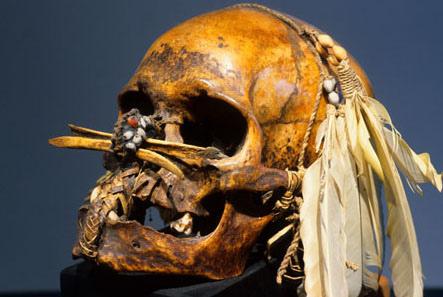Now that we have some background on Melanesian ethnography and animism, let’s look at Theodore Schwartz’s “Cult and Context: The Paranoid Ethos in Melanesia” (1973). It begins with a statement so out of place, or out of date, that one wonders whether the article is even worth reading (it is):
“The paranoid ethos may have been prevalent throughout the cultural evolutionary stratum of primitive societies.”
Say what? Here, Schwartz seems to endorse the kind of progressive and normative cultural evolutionism associated with 19th century anthropologists such as Tylor and Morgan. As they saw things from their partial and privileged western perch, all humans evolved (or were evolving) biologically and culturally from “savagery” to “barbarism” to “civilization.”
Incredibly, Schwartz combines this discredited theory with another: the characterization of entire cultures as psychoanalytic personalities. While I happen to think the latter theory can occasionally generate some keen insights (especially when applied to anal neurotic outliers like Germany), this is the speculative sort of thing best avoided in the presence of professional or polite anthropological company.
These preliminary problems aside, Schwartz then provides his Hobbesian impression of life in the Melanesian societies he spent many years studying. It’s not pretty: mortality rates are high, life spans are short, sustenance is uncertain, technology is limited, and conflict is constant. Social life is “atomic,” by which Schwartz means unstable and prone to cleavage, but in this case the incendiary meaning also seems apt. Not even clans and villages are immune, and cousins or friends not in arms become competitors for sparse material and social resources. Fear is pervasive and trust in short supply.
Everything that Schwartz describes is interpreted as being caused by, or an effect of, supernatural agencies and powers. The picture is disconcerting, even nerve-racking. As I stated in the preface to this post, what follows poses a direct challenge to those who contend that “religion” is an evolved adaptation targeted by natural selection because it enhances cooperation, trust, cohesion, and altruism:
In the Melanesian behavioral environment actuality and fantasy are mutually supportive. Persons allegedly employing sorcery may or may not have actually taken magical steps against the person who becomes ill; every sick man is seen as an injured person, a victim of attack; malice is felt to be almost omnipresent beyond the narrow circles of relative trust. The effect is the same: the individual both projects his hostility upon his environment and realistically perceives it there. Each man’s distrust and hostile defense is justified. But even where there is ever-present hostility, attack by sorcery (and the very real danger of physical attack) is a variable made constant, a principle that cannot be relaxed.
Suspicion and cognitive rejection characteristically are joined with extreme credulity. When cult phases are most intense, there is a reversal of the laws of evidence as we might conceive of them. The improbable is taken as probable, or certain; the probable is rejected as a lie. In the cargo cult, the most improbable rumor or prophetic utterances, running counter to experience, will be accepted from a person who, in a normal state, would not be given credence. Increasing disconfirmatory evidence can be rejected readily.
Religion has contributed to the cosmological setting of the paranoid ethos. In this religion it is primarily the dead who are actually operative in the affairs of the living, along with the spirits who inhabit virtually every prominent feature of the landscape.

The living and the dead, human and nonhuman beings, inhabit the behavioral environment of Melanesians. Moral supervision is exercised by the dead of a person’s own group, with sanctions of illness and threats of death. There are attacks by the malicious ghosts of other groups and by deceptive and cannibalistic ogre-spirits that inhabit the bush. There is sorcery and countersorcery. A person may be cursed by his own kin who have power to inflict barrenness, even death, on members of the family.
These are the core elements of Melanesian religion. It may be characterized in part by the familiar notion of “animism,” in which all effects have some animate or personalistic cause. Religion and magic are virtually coterminous, based on the use of supernatural instrumentalities for the attainment of the welfare of the living.
In citing this example and these passages, I am not claiming that animism cannot have the look and feel of an adaptation. Indeed, in this post I argued that some kinds of animism have precisely this look and feel. My point is that the recent proliferation of progressive or just-so stories about religion evolving as an adaptation sound nice in abstract theory but always need to be tested with history and against actual cases.
Finally, a note on Schwartz himself. He was a professor of anthropology at UC-San Diego and apparently spent many years doing fieldwork in Melanesia. I can’t find any criticism of his data or expertise, so can only assume that what he described must have had some basis in reality. This doesn’t, of course, mean that the theory by or through which he interpreted the data is correct. At the conclusion of his article, Schwartz clearly indicated that this situation no longer holds in Melanesia and that he was describing earlier societies, presumably those he personally studied.
Reference:
Schwartz, Theodore. (1973). Cult and Context: The Paranoid Ethos in Melanesia Ethos, 1 (2), 153-174 DOI: 10.1525/eth.1973.1.2.02a00020


